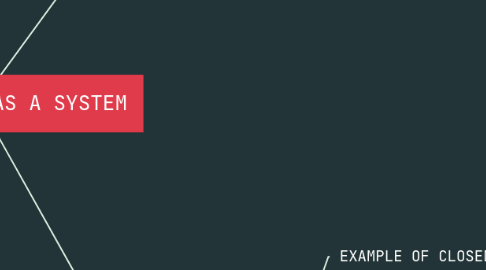
1. An open system interacts with its external environment and is typically capable of adapting and responding to external changes.
2. Closed system refers to systems having relatively little interaction with other systems or the outside environment.
3. system can be defined as an interrelated set of elements functioning as an operating unit
4. SCHOOL AS A SOCIAL SYSTEM PROCESS
4.1. INPUT
4.1.1. CHARACTERISTICS of students and teachers
4.1.2. CHARACTERISTICS of the school
4.1.2.1. TRANSFORMATION PROCESS
4.1.2.1.1. THE RELATIONSHIP OF political,structural,cultural and individual system
4.1.2.1.2. Structural systems (Bureaucratic expectations)
4.1.2.1.3. Political systems (Power relations)
4.1.2.1.4. Individual systems (Cognition and motivation)
4.1.2.1.5. Cultural systems (Shared orientations)
4.1.3. Teaching and learning Facilities
4.1.4. Environmental constraints
4.1.5. Materials and method
4.1.6. Mission and board policy
5. Open System
5.1. have capacity to change based on circumstances
5.1.1. the structure of an organizations can change based on the needs
5.1.2. can be mobile
5.1.2.1. respond to changes
5.1.2.2. interact with environments, other systems or sub-unit within other systems outside of organization
5.1.2.3. receive inputs and produce outputs
5.2. consists of 5 basic elements
5.2.1. inputs, transformation process, outputs, feedback and the environment(human, financial, physical, information resources).
5.3. EXAMPLES OF OPEN SYSTEM
5.3.1. Ecosystems eg. forests
5.3.2. Human body
5.3.3. Economic System
5.3.4. Transportation System
5.3.5. Social System
5.3.5.1. the patterned network of relationships constituting a coherent whole, exists between
5.3.5.1.1. individuals
5.3.5.1.2. groups
5.3.5.1.3. institutions
5.3.5.2. Definition: A system involving human being that influence by norms and sources in the community through politics and history.
5.3.5.3. all formal organisations are social system
5.3.5.3.1. eg. SCHOOL
6. Closed System
6.1. does not possess the capacity to change
6.2. lacks structural mobility
6.2.1. do not iinteract with external environment
6.3. EXAMPLE OF CLOSED SYSTEM
6.3.1. A watch: relatively self-contained, self maintaining unit
6.4. A CLOSED-SYSTEM THEORY VIEWS SCHOOLS AS: sufficiently independent to solve most problems through internal forces, without taking into account forces in the external environment
6.4.1. STRICT RULES AND REGULATIONS
6.4.1.1. ensure students are treated fairly and with respect
6.4.1.2. help create a sense of order and structure, promotes a safe and secure learning environment
6.4.2. ORGANIZED AND ASSIGN STUDENTS INTO SPECIFIC CLASS
6.4.2.1. create a sense of order and structure that helps students learn and understand material in organized way
6.4.3. PHYSICAL BOUNDARIES
6.4.3.1. Fences and walls: protect the school from external influences & provide a safe and secure environment for students to learn and grow
